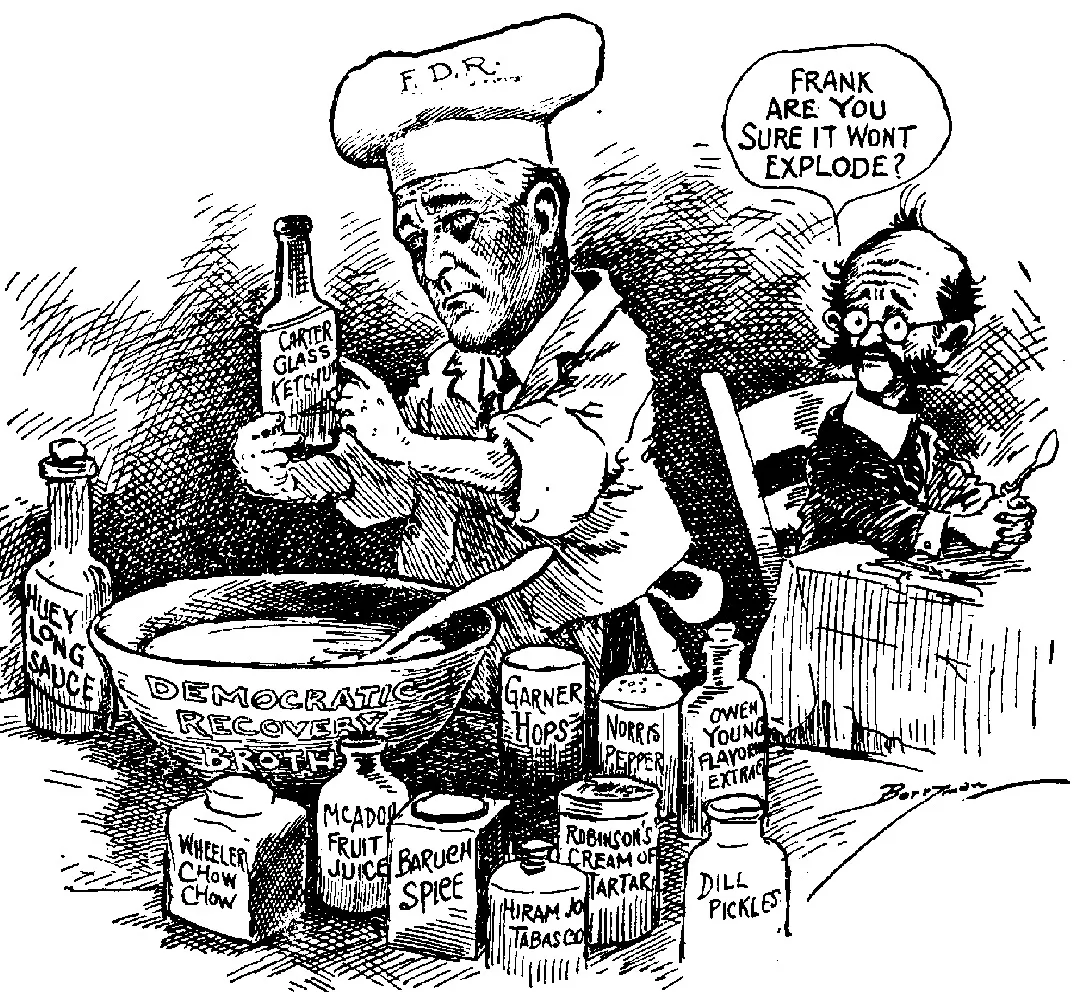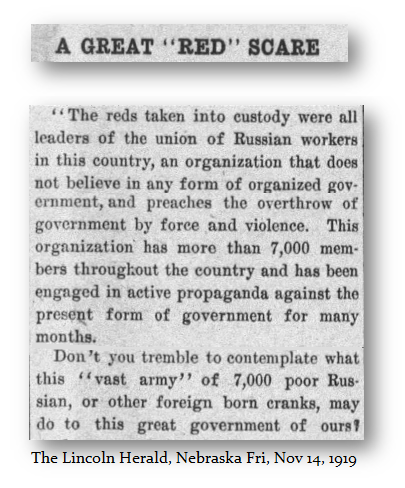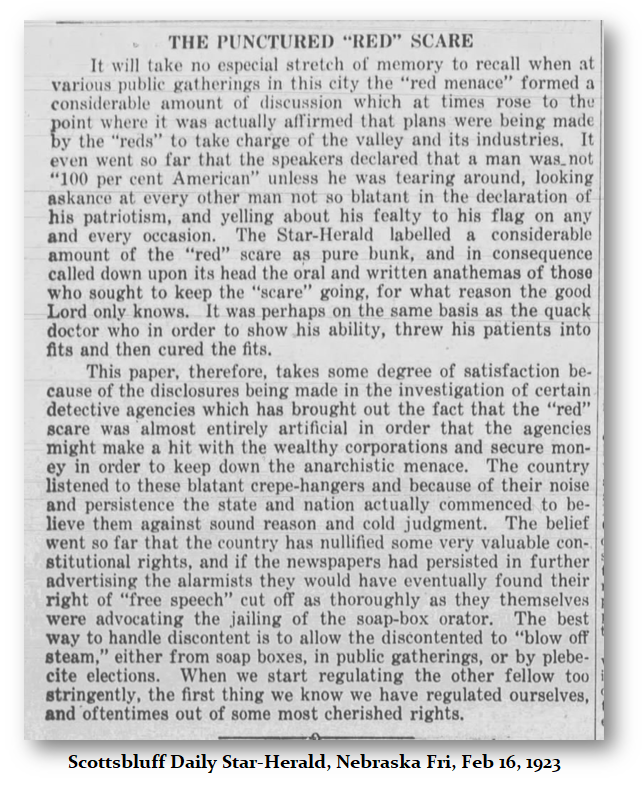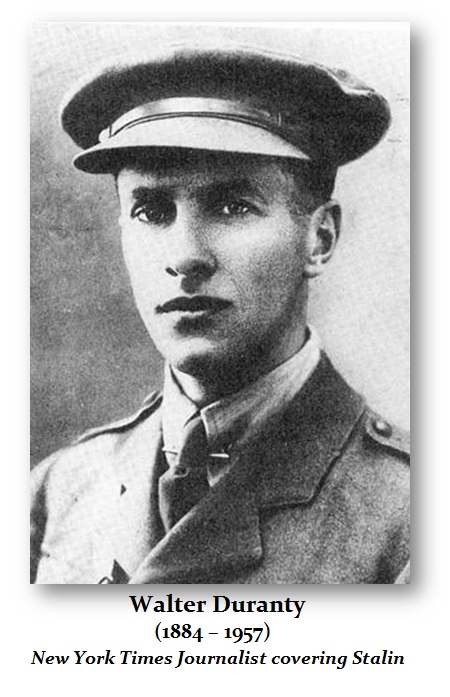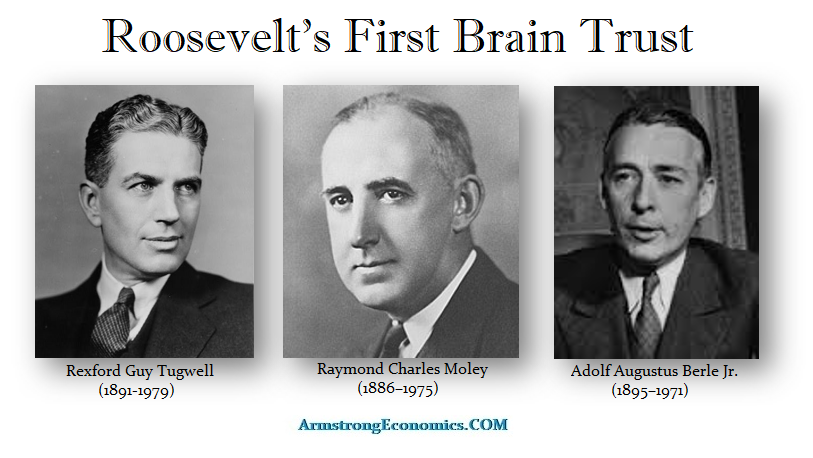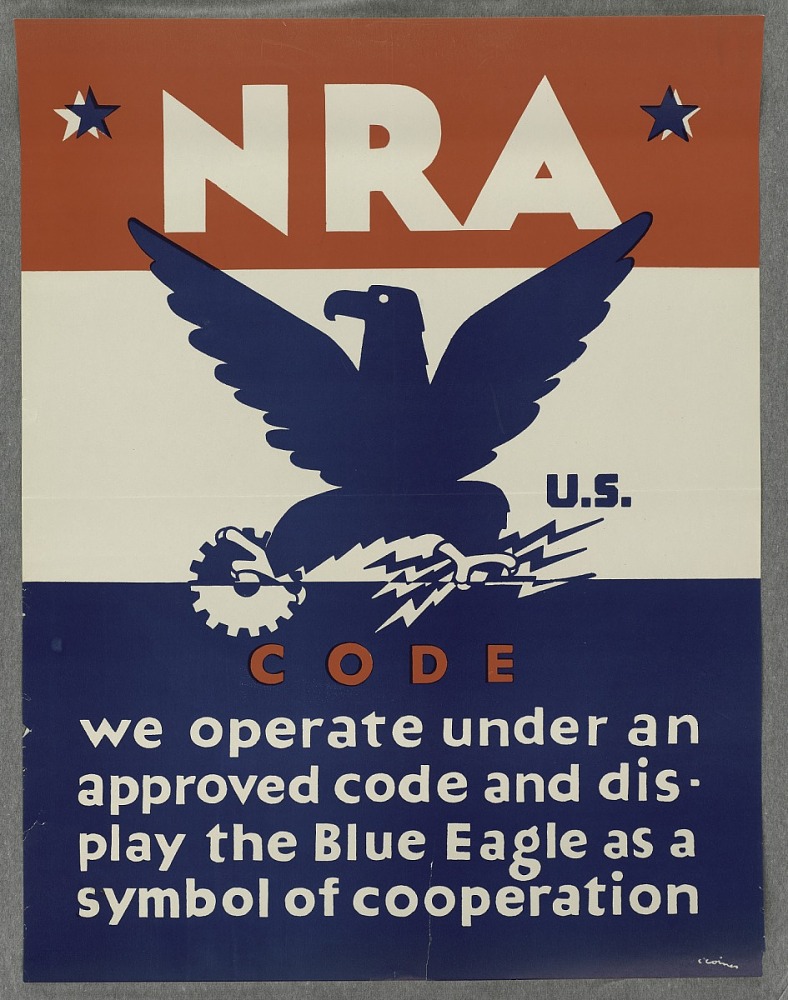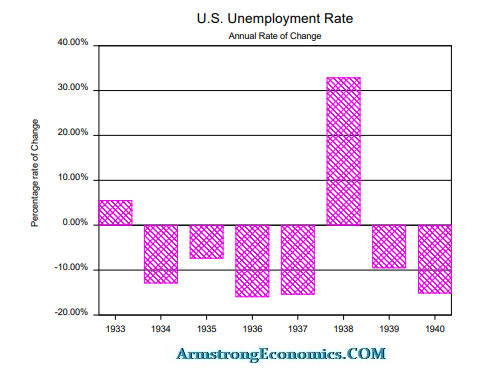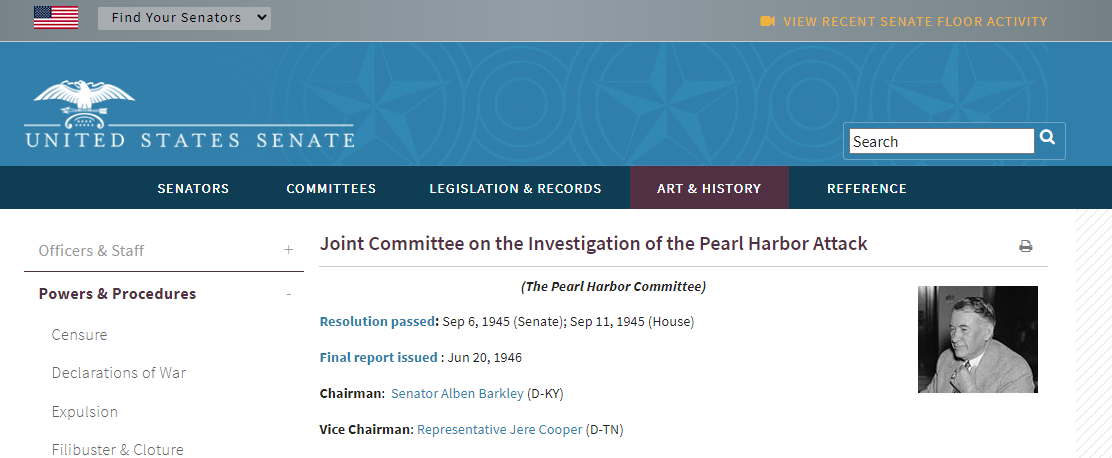August 1, 2023 | The Myth of FDR’s New Deal

The victor gets to write history, and that is precisely what the LEFT did with FDR and the New Deal. You will never be an accurate analyst unless you accept that you are duty-bound to investigate the truth no matter where it may lead. The myth of the New Deal and its success in dragging the United States out of the Great Depression still prevails. This myth was the LEFT rewriting history, which truly became the propaganda that the Democrats had clung to right up to now, the Green New Deal.
This country had a massive Red Scare following World War I from 1918 to 1923. They were targeting Russians and assuming they were all just Communists when many fled here from Communism. The Department of Justice (DOJ) exploited it just as they did terrorists. When we were going to hold a conference at the Convention Center in Philadelphia owned by the government, they demanded that we purchase Terrorist Insurance covering the entire city and the state. They did not disclose that in advance and stole our deposit when I refused to comply – typical government. The DOJ gained more power, and we suddenly had to take off our shoes to board a plane – the only country to do such a thing.
The paranoia created was used to launch Congressional hearings, censorship, and new sedition legislation used today by the Biden administration against Trump and his supporters, all because of this manufactured Red Scare. They ignored the fact that the vast majority of people who were Russians had fled Communism. Even the story of Saint Petersburg, Florida, got its name on a coin toss, as legend would have it. In 1875 John Constantine Williams of Detroit, Michigan, moved to Tampa and bought 2,500 acres of warm waterfront land that would eventually become St. Petersburg. Many years later, Peter Demens, who was an exiled Russian aristocrat fleeing Communism, financed the Orange Belt Railroad to Williams’s settlement. Williams and Demens flipped a coin to see who would name the city. Demens won the coin toss and named it after Saint Petersburg, Russia. Williams named the city’s first hotel after his birthplace, Detroit.
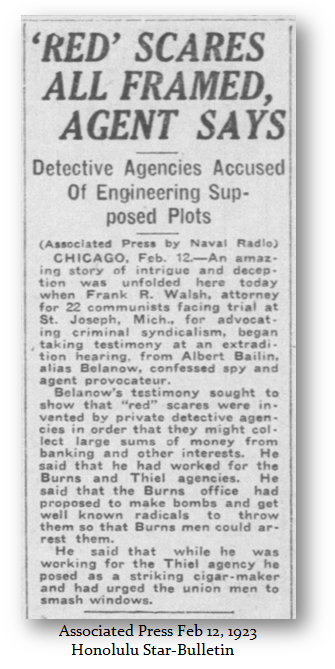 Then as now, they turned against anyone who was Russian. This was whipped up by the press and the Department of Justice as they did to the Japanese during World War II. It just seemed that they had to target someone, and this time it appeared to be Trump supporters. The interesting fact is that the Red Scare was exposed as FAKE. By 1923, the Red Scare was exposed as being manufactured to generate business. They were also targeting unions. The first victim of the Red Scare was the union of mine workers.
Then as now, they turned against anyone who was Russian. This was whipped up by the press and the Department of Justice as they did to the Japanese during World War II. It just seemed that they had to target someone, and this time it appeared to be Trump supporters. The interesting fact is that the Red Scare was exposed as FAKE. By 1923, the Red Scare was exposed as being manufactured to generate business. They were also targeting unions. The first victim of the Red Scare was the union of mine workers.
Nevertheless, it was during the New Deal that the real communists infiltrated Roosevelt’s Administration. The New York Times celebrated Joesph Stalin and communism as the future and cure for the Great Depression. Their top journalist Walter Duranty (1884-1957) even convinced Roosevelt to recognize Russia. Duranty met with Roosevelt to convince him that Communism was working and to encourage his New Deal. The mainstream press in the 1930s was very much touting the Communists. They wanted to hear of Utopia and so reported only what they wanted to believe, as they are doing once again.
The New York Times (NYT) journalist Walter Duranty on March 31, 1933, denounced reports of famine to cover up the fact that Stalin stole all the food from Ukraine. The NYT was so pro-Communism that this was the natural infiltration of Reds, but nobody did anything about that. They wanted to hear of Utopia and so reported only what they wanted to believe, as they are doing once again. The New York Times even promoted Duranty to be awarded the Pulitzer Prize for that reporting fake news. When Gareth Jones (1905-1935) in March of 1933 said this was all a lie, the truth finally began to appear. It took the New York Times until 1990 to admit they engaged in fake news pushing communism, covering up the famine in Ukraine to suggest that Stalinism was the Utopia they wanted to impose in the United States. The NYT wrote that their reporting on the Russian Revolution constituted “some of the worst reporting to appear in this newspaper.” Duranty was doing this also to support Roosevelt’s New Deal. He helped install drastic progressiveness in taxation.
Roosevelt’s New Deal was based on Marxism. His first Brain Trust consisted of a group of Columbia Law School professor Adolf Berle, Jr. (1895-1971) and an economist Raymond Moley (1886-1975). In mid-1933, Moley began his break with Roosevelt when he saw that he was becoming increasingly Marxist. He abandoned Roosevelt entirely by 1936 when it became clear that the New Deal had failed. Roosevelt replaced Moley with a decisively leftist economist named Rexford Tugwell (12891-1979). Moley became highly critical of Roosevelt and Tugwell’s policies to such an extent he switched parties and became a Republican.
Tugwell, an academic economist, embraced the Utopian ideas of Stalinism. It was Stalin who Lenin warned should not follow him. Lenin wanted Communism, but each state retained its sovereignty, whereas Stalin was authoritarian and imposed central planning and carried out his Great Purge of 1937-1938, killing between 700,000 and 1.2 million, involving anyone he thought would oppose his central planning. Tugwell sought to impose Stalin’s central panning and crafted much of the legislation in those years that cartelized industry, controlled prices, and embarked on Soviet-style projects. Tugwell was a great admirer of Soviet “achievements” in agriculture and housing, believing the fake news published by the New York Times. Roosevelt even sought to stack the Supreme Court with Soviet admirers to overrule the U.S. Constitution to create this tremendous new Soviet Utopia in America.
All of these regulations did not save the United States – they actually made it far worse. LEFTIST historians have reached a consensus that regards the accomplishments of the New Deal as the major watershed event constituting a definitive dividing line in American social-economic history. These historians present the Roosevelt administration as marking the end of the passive state dominated by big business interests and the beginning of the interventionist state. This new interventionist state was designed to curb the concentrations of business power, claiming to be the protector of the rights and interests of the powerless and underprivileged. They have projected that they alone will secure the general welfare against the capitalists and their profit-seeking agenda. Against this revision of history, the opponents saw this New Deal as a conspiracy of leftist intellectuals with the help of labor union factions. Career politicians have always maintained the public image of Marxist Socialism while selling favors for money to lobbyists.
“Mrs. Clinton said she dreamed of “open trade and open borders” throughout the Western Hemisphere. Citing the back-room deal-making and arm-twisting used by Abraham Lincoln, she mused on the necessity of having “both a public and a private position” on politically contentious issues. Reflecting in 2014 on the rage against political and economic elites that swept the country after the 2008 financial crash, Mrs. Clinton acknowledged that her family’s rising wealth had made her “kind of far removed” from the struggles of the middle class.”
Consequently, the New Deal was the 20th-century evolution of the Marxist Interventionist State. Ironically, they would cut special favors for big business that allowed the Leftist Agenda to take hold. By introducing regulations to intervene in the economy, they corrupted the government by endorsing the rise of lobbyists. What actually took place was that where big businessmen had failed to achieve monopolies during the 19th century, they turned to the Federal Government for protections of various sorts. This even allowed companies by Pfizer to be protected from lawsuits for their failure to provide safe drugs.
The great achievement reached a climax with the passage of the NationiaI Industrial Recovery Act (NIRA) of June 1933. This was one of the measures by which Roosevelt sought to assist the nation’s economic recovery during the Great Depression. This was a unique experiment in economic history that sanctioned, supported, and also enforced an alliance of industries. The Sherman Antitrust laws were actually suspended. Roosevelt insisted that companies were required to write industry-wide “codes of fair competition” that effectively fixed prices and wages, created production quotas, and imposed restrictions on the entry of other companies into the alliances. This was seeking Soviet-style control over industry without seizing private ownership. Promises of self-regulation enticed companies and declared codes of fair competition. While it was marketed as protecting consumers, competitors, and employers, the country’s various industries were to write their own regulations. Employees were given the right to organize and bargain collectively in unions. They were not to be required to join or refrain from joining a labor organization as a condition of employment.
The National Recovery Administration (NRA) was created by the National Industrial Recovery Act (NIRA) and was engaged chiefly in drawing up these industrial codes for all industries to adopt until March 1934. More than 500 codes of fair practice were adopted for various industries. Patriotic appeals were made to the public, and firms were asked to display the Blue Eagle, an emblem signifying NRA participation. However, in 1935, the U.S. Supreme Court unanimously declared the NRA unconstitutional. They held that it infringed the separation of powers under the United States Constitution. The NRA stopped operations. However, Roosevelt was not deterred, and much of the labor provisions reappeared in the National Labor Relations Act, passed later the same year – 1935. This resulted in the one-sided LEFTIST power of unions, which were the core of the New Deal but led to serious corruption over the course of the next three decades.
Yes, I know, we’ll never get rid of the Myth that the New Deal saved us, but the reality is that the Great Depression lasted longer than it would have otherwise taken due to the FDR intervention. We can see that unemployment was still greater than 10% even in 1937 despite the rally in the stock market between 1932 into 1937. It was 1938 when Roosevelt passed the Fair Labor Standards Act establishing a minimum wage. It was also when Hitler marched into Austria, establishing a geographical union of Germany and Austria. Then there was the Munich Pact, where Britain, France, and Italy agreed to let Germany partition Czechoslovakia.
As we can see, the worst unemployment actually took place in 1936, some four years after FDR was elected. So much for his policies reversing the Great Depression. The real event was war, which is why FDR allowed Pearl Harbor to occur. The scandal was that we had broken the Japanese CODE, so the question was, why did we allow Pearl Harbor to take place? They concluded that there was no direct evidence that FDR knew.
STAY INFORMED! Receive our Weekly Recap of thought provoking articles, podcasts, and radio delivered to your inbox for FREE! Sign up here for the HoweStreet.com Weekly Recap.
Martin Armstrong August 1st, 2023
Posted In: Armstrong Economics












